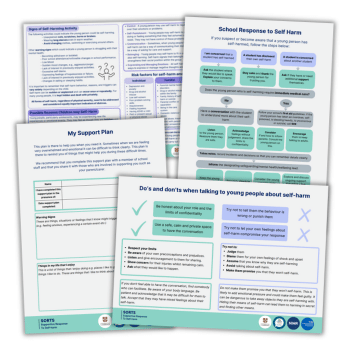Supporting students who self-harm can be challenging. However, with the right resources and strategies, teachers can make a significant difference.
These self harm support resources are from SORTS – a team of academic psychologists at the University of Cambridge. The team co-developed the resources with mental health professionals, school staff and young people. This ensures they are both practical and sensitive.
These tools aim to empower education settings to take a whole-school approach to self-harm prevention and intervention.
What’s included?
Key resources include information sheets for parents and students that explain self-harm in an accessible and non-judgemental way. This helps families better understand and support young people.
For teachers, there are guides to recognising the signs and responding to self-harm. This includes important dos and don’ts, so you feel confident when addressing these sensitive situations.
The resources also cover the cycle of self-harm and common risk factors, enabling staff to identify underlying causes and patterns.
Self harm resources
To help students manage overwhelming feelings, there is advice on coping with big emotions. Worksheets like ‘My Safety Net’ and ‘My Support Plan’ encourage students to identify their support networks and develop strategies for staying safe.
For incidents requiring documentation, the self-harm incident form ensures a structured and thorough approach to reporting. Meanwhile, the follow-up letter to parents helps you clearly communicate between school and home.
Self harm support resources for teachers
Lauren Hitchcock, a researcher within the University of Cambridge’s SORTS team, explains what self harm support resources are available for teachers…
Self-harm continues to increase in prevalence among adolescents, with school staff often being among the first to notice signs of it in a young person’s behaviour.
However, recent research has highlighted that school staff often lack confidence in discussing self-harm, potentially leading to unhelpful responses following disclosures by students – such as anxiety, shock and panic. This can impact a young person’s trust and willingness to share (see ).
SORTS training intervention
To address this, our team at the University of Cambridge has co-produced a free training toolkit for all school staff on how to recognise and respond to self-harm effectively.
SORTS (Supportive Response To Self-Harm) is a comprehensive, school-based training intervention comprising a website, e-learning module and downloadable resources.
Evidence-based self harm support
The SORTS toolkit is based on existing research evidence, developed in collaboration with the Charlie Waller Trust and a range of school mental health professionals.
We conducted focus groups and interviews with young people, as well as teaching and non-teaching school staff, to co-produce the toolkit.
Based on their feedback, we developed a training resource aimed at secondary schools and colleges. SORTS presents a whole-school approach that involves training all school staff (including those in admin and support roles) in how to build a supportive school culture.
There’s a range of free resources that schools can download via the SORTS website. The SORTS e-learning training module takes around 30 minutes to complete. You can incorporate this into staff induction sessions or other forms of staff CPD.
The training includes evidence-based information on self-harm behaviours and risk factors, quiz questions to test learners’ knowledge and video scenarios depicting student/staff interactions.
How to respond to self harm
Be sure to familiarise yourself with your school’s safeguarding procedures. Consider which colleague(s) would be best to inform and seek support from in the event of any self-harm safeguarding concerns coming to light.
When students present suspected or clear signs of behaviours linked to self-harm, here are some key things to be aware of:
- Young people may engage in intentional self-injury to manage distressing emotions.
- Intentional self-injury can occur in many different ways that young people often hide.
- Demonstrating an understanding of self-harm will signal to the young person that you accept them, and that the school knows how to help them.
- Allow time for the student to respond, and then recap what they have told you to show that you have actively listened.
- It’s important that you respond calmly and with empathy. Inform your school’s safeguarding lead so that you can put a plan in place for the student.
- Always seek personal support when processing the information shared with you.
Further advice on how to respond supportively can be found in our e-learning module.
The SORTS website includes training and information to help school staff recognise and respond to young people who self-harm. The SORTS e-learning module is designed to give you the essential knowledge and skills you need to offer a supportive response to students who self-harm. There are also videos you can watch on the website.











